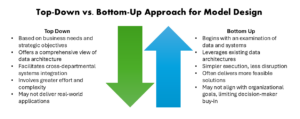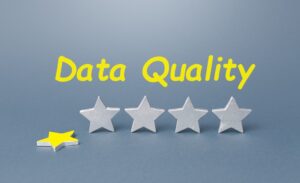
Top-Down or Bottom-Up Data Model Design: Which is Best?

When designing an effective enterprise data strategy, organizations often choose between a top-down and a bottom-up approach. Each method has its unique advantages and is suitable for various scenarios. The top-down approach begins with a high-level view of the business needs and strategic objectives, then gradually breaks down this view into detailed data structures and components. The bottom-up method, on the other hand, starts with existing data sources and systems, concentrating on specific details and progressively developing into a complete data model. Aligning the choice of approach with the organization’s strategic goals, data management needs, and existing infrastructure is paramount. In some situations, a hybrid approach that integrates both styles may be the most effective solution.
According to DAMA International’s Guide to the Data Management Body of Knowledge, enterprise data architecture typically consists of three major sets of design components. First, an enterprise data model (EDM), is an integrated, subject-oriented data model defining the essential data produced and consumed across an entire organization. EDM defines subject areas, business entities, rules, and essential data attributes. Next is the information value chain analysis, which aligns data models with business processes, organizational roles, applications, and technology platforms. Finally, related data delivery architecture includes data technology architecture, data integration, data warehousing, business intelligence, enterprise taxonomies for content management, and meta-data architecture.
Best practices include building EDMs in layers, focusing on the most critical business subject areas in a top-down or bottom-up approach. A brief overview of these layers in an EDM consists of four sections.
- Subject area model. This identifies major business subject areas defining the enterprise scope.
- Conceptual data model. The next layer defines business entities and their relationships and includes a glossary of business definitions and metadata.
- Logical data model. This model identifies the data needed for each instance of a business entity. The essential data attributes reflected in EDM represent common requirements and standardized definitions for widely shared data attributes.
- Physical data model. The final layer is physical and represents a composition of host system artifacts—physical data objects—derived from a logical data model coupled with its desired storage configuration. It details the storage configuration with tables, columns, data types, keys, and constraints.
Top-Down Approach
The top-down method of enterprise data modeling begins with an overarching perspective of the business needs and deconstructs them into more specific elements. This is because if the data strategy does not align with the business’s needs, the gathered data will be useless. The top-down approach prioritizes grasping the broader business processes and strategic objectives before focusing on the detailed components of an enterprise data model.
The top-down approach considers the company’s goals, beginning with a thorough understanding of organizational requirements. By offering a comprehensive view of the data architecture, this approach facilitates improved integration among various business units and systems on a local or global scale. This method mitigates the risk of overlooking essential business needs in data models by prioritizing high-level requirements.
Some disadvantages include greater effort and complexity and a higher time investment for extensive analysis and iterative refinements. Building a tailored approach based on existing business strategies means not knowing what or how much to build the system for. There is a possibility that the overarching model could become disconnected from practical, real-world application issues, particularly if the initial requirements are unclear or not properly documented.
Challenges frequently occur when goals and strategies aren’t aligned; strict strategies are the most effective. Decision-makers who do not have a thorough grasp of tech capabilities can organize a team of experts who deeply understand the company’s needs. Establishing critical data elements like policies, ownership, and management is paramount. Losing senior business subject matter experts (SMEs) is one of the most significant current problems, so training is vital when new staff come on board.
Bottom-Up Approach
In contrast, the bottom-up approach starts with thoroughly examining current data and systems, progressively developing a unified enterprise data model. This approach emphasizes utilizing existing data structures and systems to create a comprehensive data architecture, starting with gathering and ingesting available data sources and building domain-specific data models such as data mesh, data warehouses, and application systems.
The bottom-up approach uses current data structures and systems, which can be beneficial if the organization already has a substantial data infrastructure and knows its requirements. It is usually simpler to execute because of this, potentially resulting in less disruption and more feasible solutions. This method allows for gradual development and integration, simplifying the process of tackling problems and making necessary adjustments.
One downside is that the bottom-up approach might not completely align with overarching business goals or strategic objectives because it begins with pre-existing data. Also, there is a possibility of strengthening current data silos and inefficiencies since this approach emphasizes the integration of existing systems without necessarily tackling the fundamental structural problems. Combining various data sources can be intricate and challenging, especially when there are notable discrepancies in quality, data formats, or meanings. A significant challenge with the bottom-up approach occurs when decision-makers do not see the value of the end result early enough in the process. This can result in failure to complete the implementation due to costs or ending up with a sole-point data system, which creates long-term problems.
Taking the wrong approach for a particular business goal often ends in the strategy failing and requiring redesign from scratch. If the implementation process succeeds, it’s possible that the result will not fully support the business’s needs and potentially necessitate a restart; the legacy system could end up being better than the new system. Sticking to the three Ps—people, process, and product—when developing a data strategy is fundamental to success.
Best Practices
KPIs for a data strategy can encompass various categories, including data quality metrics that evaluate aspects such as accuracy, completeness, timeliness, and validity. Efficiency can be measured by availability, latency, and throughput metrics. Data value can be assessed through return on investment (ROI), revenue, or cost savings, and alignment metrics involve satisfaction, adoption, and engagement levels.
The following tips enable organizations to have the highest chances of success.
· Business goal alignment. It is paramount to align business goals with business vision and strategy while maintaining realistic expectations of outcomes.
· Research. Researching applicable techniques and prioritizing relevant data and technology save time and reduce costs by avoiding incompatibility with business goals.
· Scalability. Simple strategies that include scalability plans and apply industry frameworks streamline implementation.
· Data governance. Designing a thorough data governance plan is critical to meet all regulations and data needs.
· Verification. Double-checking every stage before proceeding prevents wasted time and resources.
· Flexibility. Remaining flexible and continuously reevaluating goals keeps businesses ahead of the competition. For example, Coca-Cola gathered its data into a single model through digitization, which significantly helped its business throughout the pandemic and beyond.
Top-down and bottom-up methods have solid advantages and disadvantages, and some decision-makers may opt for a hybrid. Determining the right approach will be based on the unique circumstances and requirements of the organization. Combining overall strategic alignment with specific, actionable insights allows companies to develop strong, flexible, practical data frameworks that enhance decision-making and operational effectiveness.
About the Author: Asia Banu Shaik is a senior data modeler for LTIMindtree with more than 20 years of proven expertise in crafting innovative enterprise data architecture solutions and governance and providing data strategy roadmaps. She leads and develops data models and pipelines from start to finish across diverse client projects. Asia is a senior member of an IEEE and a Certified AWS Solution Architect – Associated with working experience in AWS projects and holds a master’s degree in computer science. Connect with Asia on LinkedIn.
Related Items:
In Search of Data Model Repeatability
Data Quality Getting Worse, Report Says
Mastering Data Modeling: Insights from a Data Product Developer






























